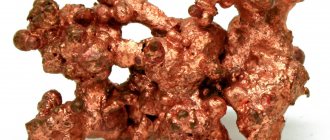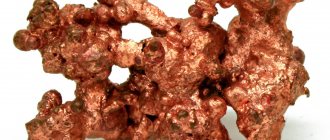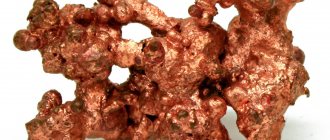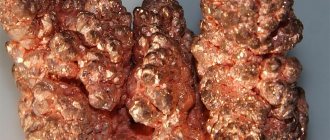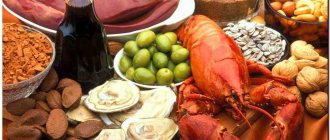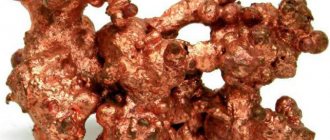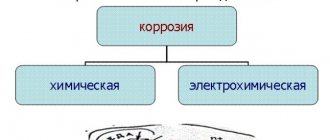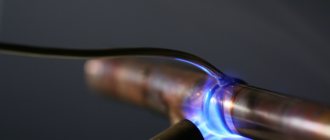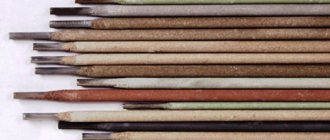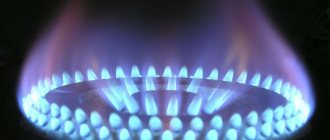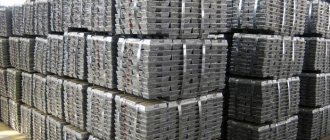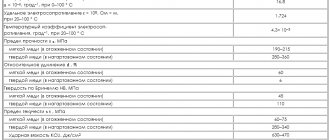Copper is in greatest demand on the secondary raw materials market. It is a non-ferrous metal with ductile properties. It has a golden pink color. The unique features of the element contribute to the formation of an oxide film on the surface of pure copper products when the metal comes into contact with air. Copper is extracted from minerals or copper ore by pyrometallurgy, electrolysis or hydrometallurgy. This metal is practically never found in its pure form. At our collection points we purchase copper at a price per kg starting from 340 rubles. We accept non-ferrous scrap for recycling, provide removal services and free estimates, and also offer markups to wholesale customers.
Physical and chemical properties of copper
In its pure form, the metal is very soft and even fluid. However, the addition of a number of elements to the alloys creates optimal properties for copper, providing a wide range of applications. The main physical and mechanical features of this metal include:
- high electrical conductivity;
- excellent thermal conductivity;
- increased density, as well as melting and boiling points;
- corrosion resistance;
- easy to process in production.
Copper does not corrode, but oxidizes easily. When interacting with air, the color of the metal changes to yellow-red, and thin sheets, when viewed through, give off green-blue hues. Almost all physical properties are determined by the composition of the alloy. When tin, iron, antimony or phosphorus are added to copper, the thermal and electrical conductivity decreases. Since the metal is not used in its pure form, the highest percentage of copper content is noticeable in electrical products (power cables, wiring, electronics, etc.).
Chemically, copper is a low-active metal. Under normal conditions, the element does not undergo oxidation. However, copper alloys react well with sulfur, selenium and halogens. The metal reacts only with acids that have oxidizing properties. Copper is amphoteric (forms cations and anions at ore locations).
Obtaining copper from mixed compounds
To obtain pure ore from mixed compounds, a pyrometallurgical method is used, which is based on exposure to fire. The rock, ground to particles 0.1-0.2 mm in size, undergoes a number of cleaning procedures:
- froth flotation,
- burning,
- melting,
- conversion,
- refining.
And now about everything in more detail and in order.
Flotation enrichment
Flotation translates to floating on the surface. Froth flotation is a beneficiation method in metallurgy, during which the useful rock rises to the surface of the pulp (a mixture of ground minerals and reagents) with air bubbles supplied from the outside. The raised mixture forms foam on the surface, which is removed using a shovel mechanism and sent for drying, and the sediment is processed for subsequent production of bricks, tiles and other products. As a result of this procedure, the copper content in the concentrate increases to 15-20%.
Flotation reagents create special conditions at the interface between air bubbles and copper compounds. Collector reagents lift Cu particles to the surface. By-products gain mass under the influence of moisture and do not float. Foaming agents create conditions for optimal foaming. Modifier reagents create the best conditions for separating similar elements from valuable ones, or perform a number of other functions.
Copper Roasting
Roasting is carried out below the melting point of the raw material in order to change the composition, remove unnecessary compounds and combine small fractions of the concentrate into larger ones. Depending on the concentrate used, firing can be stabilizing or oxidizing. Stabilizing roasting is used to obtain lower oxides and metals. Oxidative roasting is carried out to obtain sulfates or oxides.
Smelting Copper
Melting is a method of concentration in which the main part or all of the concentrate is brought to the melting point. In this case, several immiscible layers are formed:
- oxide alloys that float to the surface (slag)
- and a top layer of iron and non-ferrous metal sulfides (matte).
Matte is a layer of the bulk of non-ferrous metals (Cu, Ni, S), salts and others. Sometimes, as a result of smelting, on the contrary, slag becomes valuable. The copper concentration after smelting is more than 50%.
Conversion
Copper conversion takes place in 2 stages in a converter (a cylindrical unit into which air is supplied from below or onto the surface of the metal).
At the first stage, iron residues are removed by adding silica (SiO2) to the flux melt and supplying oxygen. Silica slag makes up 21-30%, the rest is iron. After this procedure, the copper melt is called white matte. In the second stage, the white matte is oxidized by oxygen and separation occurs again. The end product of copper conversion is blister copper.
Refining
Refining - the final purification of metal from impurities is carried out in two stages: fire and electrolytic methods.
Fire refining is carried out in anode furnaces with a horizontal converter. Blister copper is loaded into the furnace, followed by melting, oxidation and reduction treatment, and casting. The oxidation process involves supplying air to the melt to a depth of 600 to 800 mm. Impurities with a high affinity for oxygen Fe, Al, Ni, Sn, Sb, Zn, Bi, As, as well as part of copper are oxidized to the state of Cu2O. At the recovery stage, the melt is treated with natural gas or para-fuel mixtures. As a result of a chemical reaction, the melt is mixed, gases are removed from it, and part of the oxidized Cu2O is reduced. Alloy containing S.
In the second stage, the anodes are immersed in box-shaped baths. Pure copper cathodes are suspended between them, through which electricity is supplied. All copper goes from anodes to cathodes in 30 days. Cathodes are unloaded in batches every 6-12 days. Many useful elements, such as Gold and Silver, are isolated from the sediments in the electrolyte.
Copper Applications
The unique properties and performance characteristics of the metal have led to its use in almost all areas of human activity. Main Applications:
- Electrical engineering. The metal has a low resistivity, therefore it is actively used for the manufacture of power cables, wires, transformers and conductors used in electrical engineering.
- Heat exchange. Due to its effective thermal conductivity, copper is one of the main metals used for the manufacture of heat exchangers and heat dissipation equipment (radiators, air conditioners, coolers, etc.).
- Pipe production. Often, to create a utility network, pipes with high resistance to corrosion, pressure and chemical reactions are required. Copper and its alloys are an excellent solution for arranging water supply and heating systems.
Copper is also used in medicine, automotive, agriculture, domestic use and many other fields.
Copper in construction - down conductors, roofing
In the construction of houses, copper is invariably used as lightning rods and lightning protection. For lightning protection, a copper core 8 mm thick made of pure copper is used, that is, for this you need MM grade copper wire, since the purity of this grade of copper ensures effective current drainage. Copper sheets are also used in construction as roofing. Copper, which already has good anti-corrosion properties, thanks to the formation of a patina on the surface of sheets or strips of deoxidized copper, lasts for more than 2 centuries, during the life of at least five generations of home owners.
Types of copper alloys
Copper is actively used as a component in many metallic and non-metallic compounds. However, as the main element, this metal is used to create the following alloys:
- Brass. The alloying component is zinc or tin. The composition also contains manganese, nickel, iron, lead and other substances. Typically, brass alloys contain about 60-70% copper. The remaining 30-40% comes from alloying metal and additional elements.
- Bronze. Divided into tin or tin-free. The amount of copper in the alloy is usually approximately 80%, the remaining 20% comes from the alloying element with a spread of additional substances within 3%.
- Cupronickel. An alloy of copper (up to 60%) and nickel (about 40%). There are individual copper-nickel alloys in which Ni reaches 67% of the total volume of the alloy.
There are also double brasses and multi-component compositions in which a large amount of copper is present (for example, tombac - up to 97% copper). However, such metals have limited applications.
Extraction and raw materials
The copper content in the earth's crust is 4.7-5.5 * 10-3% of the total mass. Sea water contains about 3*10-7%. Most copper deposits are of geothermal origin. Rich reserves of copper are found at the bottom of the seas and oceans in the form of sediments of 5.7 * 10-3% of the total share.
In nature, Cu is present as a mixture of two active isotopes (atoms with the same chemical number, but different mass numbers). Cu occurs in the form of nuggets, but more often in mixed form. Cu is produced mainly from compounds that contain S (Sulfur) (they are called sulfides), or oxides (compounds with oxygen), or from carbonates (CO3 in the base).
22% of copper is mined in Chile, 20% in the USA, 9% in the former CIS countries, 7.5% in Canada, and about 5% in Zambia. Most of the large deposits of native copper have now been mined. It is produced from mixed ores, the copper content of which is 0.5-1.2%. 1/3 of copper products are made from recycled materials.
The main interest for miners is chalcopyrite CuFeS2 (more than 50% of copper reserves). Copper is also mined from sulfide compounds: chalcocite CuxS, covellite CuS, Cu5FeS4 bronite, or oxygen-containing compounds: CuCO3Cu(OH)2 malachite, Cu2O cuprite, CuSiO3H2O chrysocolla.
Rocks containing copper are mined in quarries. Quarries can be developed by chipping using excavators, as well as using explosives. The bulk of work in quarries is performed by quarry excavators with buckets with a capacity of up to 25 m3 and trucks capable of transporting up to 250 tons of valuable rock.
Copper as non-ferrous scrap
Metal is bought on the secondary market at high prices. The demand for copper is constantly growing. The main sources of copper scrap are:
- household electrical wiring;
- elements of household appliances;
- car parts;
- heating radiators;
- old pipes and so on.
However, owners are not always able to distinguish ordinary copper from its alloys. The cost of by-products is lower. To find out how to distinguish copper, read the detailed article on our website here.
Features of copper processing
Initially, copper ore is formed into ingots of various shapes. Next comes their processing, which can be done in various ways:
- mechanical restoration;
- heat treatment;
- turning method.
The main importance of heat treatment of copper is to impart certain properties to the material. These include elasticity, hardness, and durability. In some cases, copper is specially heated to 600 degrees and allowed to cool in air. To obtain soft copper parts, they are heated to the same temperature and quickly cooled in water. The mold is heated again to 400 degrees and allowed to cool in the open air.
The mechanical method of metal processing serves, first of all, to give shape and pattern. Before carrying out the process, the part should be cleaned of grease, oil and other contaminants. Next, the copper product manufacturer resorts to one of four methods:
- grinding;
- polishing;
- rolling;
- broaching
Rolling of the product is carried out on a special unit through which sheet copper is passed. The design of the device allows you to control and set the required thickness of the product. A special emulsion coats copper with a thin layer of film.
The turning method is also very popular. It is produced on special machines using cutters. Using this method, industrial copper products of various shapes are obtained. Turning workshops often work on individual orders, since the design of the machines allows for customization for a specific part.
